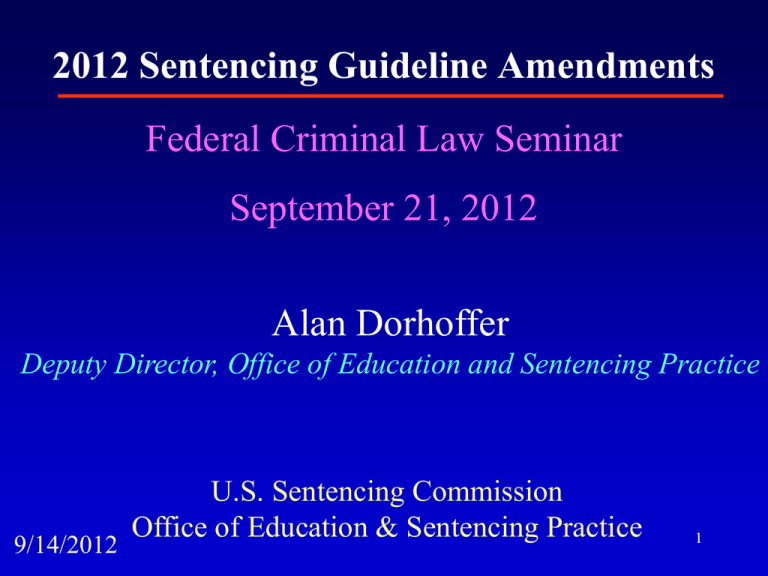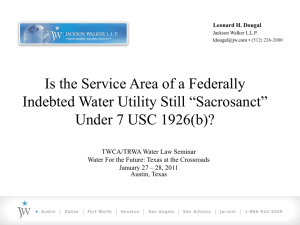
2012 Sentencing Guideline Amendments
Federal Criminal Law Seminar
September 21, 2012
Alan Dorhoffer
Deputy Director, Office of Education and Sentencing Practice
9/14/2012
U.S. Sentencing Commission
Office of Education & Sentencing Practice
1
Discussion Outline
• Amendments
• Supreme Court Cases
• Sixth Circuit Case Law
2
U.S.S.C.
HelpLine
202-502-4545
Web Site
www.ussc.gov
3
Commission Sentencing Statistics
4
Primary Offense Types
National - FY 2011
Drugs
29.1%
Immigration
34.9%
Firearms
9.2%
Fraud
9.8%
White
Collar
3.6%
Larceny
1.8%
Other
9.4%
Child Porn
2.2%
5
SOURCE: U.S. Sentencing Commission, 2011 Datafile USSCFY11: 85,122 of 86,201 cases
Primary Offense Types
Southern District of Ohio - FY 2011
6
SOURCE: U.S. Sentencing Commission, 2011 Datafile OPAFY11: 743 of 744 cases
Position of Sentences in Relation to Guideline Range
National - FY 2011
Below
Guideline
Range
43.7%
Other
Below
17.4%
Other Govt
15.1%
§5K1.1
11.2%
Within
Guideline
Range
54.5%
Above
Guideline
Range 1.8%
7
SOURCE: U.S. Sentencing Commission, 2011 Datafile USSCFY11: 84,744 of 86,201 cases
Position of Sentences in Relation to Guideline Range
Southern District of Ohio - FY 2011
Below
Guideline
Range
63.8%
Other
Below
26.9%
Within
Guideline
Range
34.4%
§5K1.1
29.7%
Above
Guideline
Range 1.9%
8
SOURCE: U.S. Sentencing Commission, 2011 Datafile OPAFY11: 741 of 744 cases
Median Sentences For Selected Offenses
Fiscal Year 2011
Offense Type
National
Median
S. Ohio
Median
Immigration
12
6
Drug Trafficking
60
46
Fraud
18
21
Firearms
60
70
Child Pornography
84
48
Cases missing information on position of sentence relative the guideline range were excluded from this analysis.
SOURCE: U.S. Sentencing Commission, 2011 Datafile, OPAFY11
Five Year Trends in Average Sentence
for Selected Offenses
Fiscal Years 2007-2011
Months
Cases missing information on primary offense type or with missing or indeterminable sentencing information were excluded from this analysis. Sentences of probation only are included in this analysis as zero
months of imprisonment. In addition, the information presented in this figure includes time of confinement as described in USSG §5C1.1.
SOURCE: U.S. Sentencing Commission's Interactive Sourcebook (www2.usscsourcebook.org) Preliminary Tables using the Commission's fiscal year 2007-2011 Datafiles, USSCFY2007-USSCFY2011.
Commission Update
• Proposed 2012 amendments
• Commission public hearings and Reports
– Child pornography
– Booker
• Commission Report to the Congress
– Mandatory Minimum Penalties, submitted Oct. 2011
11
2012 Proposed Amendments
Passed by the Commission on April 13, 2012
for Submission to Congress by May 1, 2012
Will Become Effective November 1, 2012
Unless Rejected by Statute
12
2012 Proposed Amendments
• Mortgage fraud
• Securities fraud and insider training
• 2-level reduction at §2D1.11 (Listed
chemicals)
• “Human Rights” guideline
• Eliminates §5K2.19 (Post-sentencing
rehabilitation)
13
Proposed Amendments
for November 1, 2012
Mortgage Fraud – §2B1.1
• Creates a rebuttable presumption that, if the
property is not disposed of by the time of
sentencing, the most recent tax assessment at the
time of plea is the fair market value
14
Proposed Amendments
for November 1, 2012 (cont.)
Securities Fraud – §2B1.1
• New rule for the determination of “loss” in
offenses involving fraudulent inflation or
deflation in the value of securities
• Provides a departure example of a fraud where
the offense level overstates the seriousness of the
offense:
– A fraudulent statement made publicly to the securities
market that resulted in numerous victims and a
substantial aggregate loss, but only a small amount15 of
loss to each of the victims
Proposed Amendments
for November 1, 2012 (cont.)
Chemical & Drug Offenses
• A “safety valve” SOC for a 2-level reduction added
at §2D1.11 (Listed Chemicals)
16
2011 Amendments
Highlights
Effective November 1, 2011
17
Supervised Release
§§5D1.1 & 5D1.2
• Lowers the minimum term of supervised release
required by the guidelines for certain defendants
when a statute does not require a higher
minimum term:
– At least three two years but not more than five years
for a defendant convicted of Class A or B felony
– At least two one years but not more than three years
for a defendant convicted of Class C or D felony 18
Supervised Release (cont.)
§§5D1.1 & 5D1.2
• New subsection at §5D1.1(c) provides that,
unless required by statute, supervised release
ordinarily should not be imposed if the
defendant is a deportable alien who will likely
be deported after imprisonment
19
Early Termination & Extension
of Supervised Release
§5D1.2, App. Note 5
The court may wish to consider early termination
if the defendant is a drug or alcohol abuser who
successfully completes a treatment program,
thereby reducing the risk to the public from
further crimes of the defendant
20
Health Care Fraud
New §2B1.1(b)(8)
• If the defendant was convicted of a Federal
health care offense involving a Government
health care program; and
• Loss under the “loss table” at §2B1.1(b)(1) to
the Government health care program was
– more than $ 1,000,000
– more than $ 7,000,000
– more than $20,000,000
+2 levels
+3 levels
+4 levels
21
Health Care Fraud (cont.)
§2B1.1
• Provides definitions of “Federal health care
offense” & “Government health care program”
• Adds new special rule in App. Note 3(F) for
determining intended loss in a Federal health
care fraud:
– “The aggregate dollar amount of fraudulent bills
submitted to the Government health care program
shall constitute prima facie evidence of the amount
of the intended loss, if not rebutted.”
22
Health Care Fraud (cont.)
§3B1.2 Mitigating Role, App. Note 3(A)
• Amended to indicate that a mitigating role is
not precluded for a defendant who is
accountable under relevant conduct (§1B1.3)
for a loss amount under §2B1.1 that greatly
exceeds the defendant’s personal gain from a
fraud offense and who had limited knowledge
of the scope of the scheme
23
Mitigating Role
§3B1.2
• Deletes unnecessary language that may have
discouraged the application of the adjustment
– App. Note 3(C): “[a]s with any other factual issue, the
court, in weighing the totality of the circumstances, is
not required to find, based solely on the defendant’s
bare assertion; that such a role adjustment is warranted.”
– App. Note 4: “[i]t is intended that the downward
adjustment for minimal participant will be used
infrequently.”
24
Firearms
§2K2.1
• Increases BOLs for “straw purchasers”
convicted under 18 USC § 922(a)(6) or
924(a)(1)(A) who commit the offense with
knowledge, intent, reason to believe that the
offense would result in transfer of firearm or
ammunition to a prohibited person
– Increased from 12 to 14 generally
– Increased from 12 to 20 if certain firearms involved
– Departure provision at App. Note 15 for certain
“less culpable” straw purchasers
25
Fair Sentencing Act:
Guideline Amendment
• Re-promulgates as permanent the temporary,
emergency amendment of November 1, 2010
• The November 1, 2011 amendment is
essentially identical to the emergency
amendment except for additional guidance
regarding “maintaining a premises” under
§2D1.1(b)(12)
– §2D1.1, App. Note 28
26
Guideline Amendment Retroactivity
• “Retroactivity” of a guideline amendment allows
the sentencing court to consider a possible
reduction of imprisonment for inmates meeting
certain criteria set by statute and the guidelines
– See U.S. v. Jackson, 678 F.3d 442 (6th Cir. 2012)
27
Application of FSA Retroactive
Crack Cocaine Amendment
Granted
Denied
Avg. Reduction (mos.) Av g. Reduction
(%)
National
4,456
2,049
28 months
20.3%
Southern Ohio
97
11
22 months
18.7%
28
Supreme Court Case Involving
The Fair Sentencing Act
29
Fair Sentencing Act statutory penalties
Dorsey v. United States
132 S. Ct. 2321 (2011)
• The Fair Sentencing Act’s new, lower
mandatory minimums apply to the post-Act
sentencing of pre-Act offenders.
– U.S. v. Wright, 2012 WL 3871873 (6th Cir. 2012)
– U.S. v. Allen, 2012 WL 3038171 (6th Cir. 2012)
– U.S. v. Finley, 2012 WL 2505630 ( 6th Cir. 2012)
30
Supreme Court Cases Involving
Sentencing Issues
31
Cert granted: Plain error
• Henderson v. U.S., 646 F.3d 223 (5th Cir. 2012), cert.
granted, 2012 WL 894491 (U.S. 2012)
• Question Presented: “Whether, when the governing
law is unsettled at the time of trial but settled in the
defendant’s favor by the time of appeal, an appellate
court reviewing for “plain error” should apply
Johnson v. United States’s time-of-appeal standard, as
the First, Second, Sixth, Tenth, and Eleventh Circuits
do, or should apply the Ninth Circuit’s time-of-trial
standard, which the D.C. Circuit and the panel below
have adopted.”
32
Post-Sentencing Rehabilitation
and Remand
Pepper v. U.S.
131 S. Ct. 1229 (2011)
• Upon remand a federal district judge can
consider a defendant’s post-sentencing
rehabilitation as a permissible factor
supporting a sentencing variance under §
3553(a)
33
Rehabilitation
Tapia v. U.S.,131 S. Ct. 2382 (2011)
• A district court may not impose or lengthen
a term of imprisonment in order to promote
the defendant’s rehabilitation
•
•
•
•
•
•
•
U.S. v. Jackson, 2012 WL 1449681 (6th Cir. 2012)
U.S. v. Tucker, 468 F. App’x 610 (6th Cir. 2012)
U.S. v. Sanders, 472 F. App’x 376 (6th Cir. 2012)
U.S. v. Tolbert, 668 F.3d 798 (6th Cir. 2012)
U.S. v. Walker, 649 F.3d 511 (6th Cir. 2011)
U.S. v. Censke, 449 F. App’x 456 (6th Cir. 2011)
U.S. v. Brooks, 431 F. App’x 460 (6th Cir. 2011)
34
Consecutive Sentence Authority
Setser v. U.S., 132 S. Ct. 1463 (2012)
• A District Court has discretion under 18 U.S.C. §
3584(a) to order that a defendant’s sentence run
consecutively to his anticipated, but not yet
imposed, state sentence
• See U.S. v. Quintero, 157 F.3d 1038 (6th Cir.
1998) (not allowed)
35
“Violent Felony” and ACCA
Sykes v. U.S.,131 S. Ct. 2267 (U.S. 2011)
• Felony vehicle flight as proscribed by
Indiana law is a “violent felony” within the
meaning of the Armed Career Criminal Act
36
“Violent Felony” and ACCA (cont.)
Sykes v. U.S.,131 S. Ct. 2267 (U.S. 2011)
• The crime of using a vehicle to knowingly
or intentionally flee from a law enforcement
officer is not a strict-liability, negligence, or
reckless crime, and as a categorical matter is
similar in risk to the crimes enumerated in
the ACCA
37
Recent Supreme Court Cases
Involving “Violent Felony” (cont.)
• Sykes v. U.S. 131 S. Ct. 2267 (2011)
– Indiana felony vehicle flight which involved
intentional fleeing is a violent felony
– For crimes involving intentional conduct, the only
relevant inquiry is whether the crime presents a
serious potential risk of physical injury to another
– Limits Begay’s additional requirement of
“purposeful, violent, and aggressive conduct” to
strict liability, negligent, or reckless crimes
38
Derby v. U.S., 131 S. Ct. 2858 (2011)
cert. denied dissent by Scalia regarding ACCA
• “Certainly our most recent decision interpreting ACCA’s
residual clause, Sykes v. United States, would be of no
help. The “rule” we announced there, as far as I can tell, is
as follows: A court must compare the degree of risk of the
crime in question with the degree of risk of ACCA’s
enumerated offenses (burglary, extortion, arson, and
crimes involving the use of explosives) as a “beginning
point,” look at the statistical record, which is not
“dispositive” but sometimes confirms “commonsense
conclusion[s],” and check whether the crime is
“purposeful, violent, and aggressive,” unless of course the
crime is among the unspecified “many cases” in which
that test is “redundant with the inquiry into risk.”
39
Derby v. U.S., 131 S. Ct. 2858 (2011)
cert. denied dissent by Scalia regarding ACCA
• If it is uncertain how this Court will apply Sykes
and the rest of our ACCA cases going forward, it is
even more uncertain how our lower-court
colleagues will deal with them. Conceivably, they
will simply throw the opinions into the air in
frustration, and give free rein to their own feelings
as to what offenses should be considered crimes of
violence—which, to tell the truth, seems to be what
we have done.
40
Derby v. U.S., 131 S. Ct. 2858 (U.S. 2011)
cert. denied dissent by Scalia regarding ACCA
• Before throwing the opinions into the air, however,
they should check whether littering—or littering in
a purposeful, violent, and aggressive fashion—is a
felony in their jurisdiction. If so, it may be a
violent felony under ACCA; or perhaps not.
• Since our ACCA cases are incomprehensible to
judges, the statute obviously does not give
“person[s] of ordinary intelligence fair notice” of
its reach.” I would grant certiorari, declare ACCA's
residual provision to be unconstitutionally vague,
and ring down the curtain on the ACCA farce
playing in federal courts throughout the Nation. 41
Cert. Granted:
ACCA and Modified Categorical Approach
U.S. v. Descamps, 466 F. App’x 563 (9th Cir. 2012),
cert. granted, 2012 WL 1031489 (U.S. 2012)
• Question Presented: Whether, in a case under the
Armed Career Criminal Act, when a state crime
does not require an element of the federal crime of
burglary, the federal court may find the existence of
that element by examining the record of the state
proceedings under the modified categorical
approach
42
6th Circuit VF & COV Cases
• U.S. v. Amos, 2012 WL 3608600 (6th Cir. 2012)
– Court could use probable cause statement incorporated
into a sentencing hearing
• U.S. v. Anderson, 2012 WL 4009702 (6th Cir.
2012)*
– OH aggravated assault is a VF under force
– OH felonious assault is a VF
• Jones v. U.S., 2012 WL 3089348 (6th Cir. 2012)*
– KY reckless homicide is not a VF
• Kirk v. U.S., 2012 WL 3064766 (6th Cir. 2012)
– OH aggravated vehicle assault is not a VF
• U.S v. Doyle, 678 F.3d 429 (6th Cir. 2012)
– TN Class E evading arrest is a VF
43
6th Circuit VF & COV Cases
• U.S. v. Johnson, 675 F.3d 1013 (6th Cir. 2012)
– MO assault is a VF under modified categorical U.S. v.
Jones, 673 F.3d 497 (6th Cir. 2012)
– TN burglary statute (1982) was a VF
– TN intent to commit 1st degree murder was a VF
– TN intent to commit 2nd degree murder was a VF
• U.S. v. Sosa, 448 F. App’x 605 (6th Cir. 2012)
– IL burglary was a VF under modified approach
• U.S. v. Clark, 458 F. App’x 512 (6th Cir. 2012)
– KY wanton endangerment in 1st degree was a VF
• U.S. v. Fraker, 458 F. App’x 461 (6th Cir. 2011)
– TN robbery is a VF under modified approach
44
6th Circuit VF & COV Cases
• U.S. v. White, 455 F. App’x 647 (6th Cir. 2012)
– TN aggravated assault is a VF under modified
• U.S. v. Oaks, 665 F.3d 719 (6th Cir. 2012)
– TN escape from a “unsecured courtroom was not a VF
• U.S. v. LeMaster, 445 F. App’x 851 (6th Cir. 2012)
– OH 4th degree burglary is a VF under modified
• U.S. v. Meeks, 664 F.3d 1067 (6th Cir. 2012)
– KY 1st degree wanton endangerment is COV
• U.S. v. Rodriguez, 664 F.3d 1032 (6th Cir. 2011)
– OH 4th degree aggravated assault is a COV
• U.S. v. Gloss, 661 F.3d 317 (6th Cir. 2011)
– TN facilitation of aggravated robbery (robbery must
occur) is a VF
45
6th Circuit VF & COV Cases
• U.S. v. Coleman, 655 F.3d 480 (6th Cir. 2011)
– OH 3rd degree burglary is a VF
• U.S. v. McMurray, 653 F.3d 367 (6th Cir. 2011)
– TN aggravate assault not a VF
• U.S. v. Briggs, 431 F. App’x 389 (6th Cir. 2011)
– KY manslaughter is a VF (wanton)
• U.S. v. Benton, 639 F.3d 723 (6th Cir. 2011)
– TN solicitation to commit aggravated assault is a VF
under residual clause, not force clause
• U.S. v. Noah, 401 F. App’x. 54 (6th Cir. 2010)
– TN intentionally evading arrest in a car is a VF
• U.S. v. Gibbs, 626 F.3d 344 (6th Cir. 2010)
– MI 2nd degree home invasion is a COV
– MI “walk-away” escape not a COV
46
6th Circuit VF & COV Cases
• U.S. v. Vanhook, 640 F.3d 706 (6th Cir.2011)
– TN facilitation of burglary of building not a VF
• U.S. v. Mosley, 635 F.3d 859 (6th Cir. 2011)
– MI shooting pepper spray at person w/out justification
is a COV
• U.S. v. Culbertson, 389 F. App’x 515 (6th Cir.
2010)
– MI manslaughter with a car is not a VF
• U.S v. Young, 580 F.3d 373(6th Cir. 2009)
– MI fleeing and eluding is a VF
• U.S. v. Wynn, 579 F.3d 567 (6th Cir. 2009)
– OH sexual battery is not categorically a COV
• U.S. v. Evans, 378 F. App’x 485 (6th Cir. 2010)
– TN statutory rape is not categorically a COV
47
6th Circuit VF & COV Cases (cont.)
• U.S. v. Ford, 560 F.3d 420 (6th Cir. 2009)
– KY walk-away escape is not a COV
• U.S. v. Baker, 559 F.3d 443 (6th Cir. 2009)
– TN reckless endangerment is not categorically a COV
• U.S. v. Oaks, 554 F.3d 1087 (6th Cir. 2009)
– TN escape remand to determine type of escape
• U.S. v. Hawkins, 554 F.3d 615 (6th Cir. 2009)
– Fed possession of sawed-off shotgun is a COV
• U.S. v. Alexander, 543 F.3d 819 (6th Cir. 2008)
– MI battery and assault is a COV
• U.S. v. Bartee, 529 F.3d 357 (6th Cir. 2008)
– MI attempted sexual conduct is not categorically COV
48
Reasonableness Review
49
Procedural Reasonableness and
Substantive Reasonableness
• Sentences are first reviewed for procedural
reasonableness, e.g.,
– Correct guideline application
– Proper consideration of the § 3553(a) factors
– All non-frivolous arguments by the parties were
addressed
– No clearly erroneous facts were relied upon
– The chosen sentence was adequately explained
50
Procedural Reasonableness and
Substantive Reasonableness (cont.)
• If procedural reasonableness has been met,
then sentences are reviewed for substantive
reasonableness
– In reviewing for substantive reasonableness,
“the appellate court will take into account the
totality of the circumstances, including the
extent of any variance from the Guidelines
range” - Gall
51
Appellate Cases Regarding
Departures and Variances
52
Examples of Below Guideline Sentences Affirmed
6th Circuit
• U.S. v. Amawi, 2012 WL 3602313 (6th Cir. 2012)
– Terrorism
• U.S. v. Richards, 659 F.3d 527 (6th Cir. 2011)
– Production of child porn
• U.S. v. Stall, 581 F.3d 276 (6th Cir. 2009)
– Possession of child porn
• U.S. v. Guthrie, 557 F.3d 243 (6th Cir. 2009)
– Car jacking
53
Examples of Below Guideline Sentences Affirmed
6th Circuit
• U.S. v. Presley, 547 F.3d 625 (6th Cir. 2008)
– Cocaine and money laundering
• U.S. v. Beach, 275 F. App’x 529 (6th Cir. 2008)
– Transporting child porn
• U.S. v. Grossman, 513 F.3d 592 (6th Cir. 2008)
– Possession of child porn
54
Examples of Below Guideline Sentences Remanded
6th Circuit
• U.S. v. Williams, 687 F.3d 283 (6th Cir. 2012)
– Court improperly considered factors besides assistance
• U.S. v. Robinson, 669 F.3d 767 (6th Cir. 2012)
– Possession of child porn
• U.S. v. Bistline, 665 F.3d 758 (6th Cir. 2012)
– Possession of child porn
• U.S. v. Hawn, 446 F. App’x 793 (6th Cir. 2012)
– §5K1.1 court considered factors besides assistance
• U.S. v. Traxler, 2012 WL 128266 (6th Cir. 2012)
– §5K1.1 court considered factors besides assistance
• U.S. v. Christman, 607 F.3d 1110 (6th Cir. 2010)
– Possession of child porn
55
Examples of Below Guideline Sentences Remanded
6th Circuit
• U.S. v. Camiscione, 591 F.3d 823 (6th Cir. 2010)
– Possession of child porn
• U.S. v. Harris, 339 F. App’x 533 (6th Cir. 2009)
– Possession and distribution of child porn
• U.S. v. Hunt, 521 F.3d 636 (6th Cir. 2008)
– Health care fraud
• U.S. v. Davis, 537 F.3d 611 (6th Cir. 2008)
– Bank fraud
• U.S. v. Hughes, 283 F. App’x 345 (6th Cir. 2008)
– Bank fraud
56
Examples of Above Guideline Sentences Remanded
6th Circuit
• U.S. v. Aleo, 681 F.3d 290 (6th Cir. 2012)
– Production of child porn
• U.S. v. Censke, 449 F. App’x 456 (6th Cir. 2011)
– Threatening communications
• U.S. v. Hreha, 429 F. App’x 579 (6th Cir. 2011)
– Bank fraud
• U.S. v. Worex, 420 F. App’x 546 (6th Cir. 2011)
– Firearms
57
Examples of Above Guideline Sentences Affirmed
6th Circuit
• U.S. v. Watkins, 2012 WL 3538261 (6th Cir. 2012)
– Bribery
• U.S. v. Davis, 2012 WL 2354359 (6th Cir. 2012)
– Robbery
• U.S. v. McCafferty, 2012 WL 1970777 (6th Cir. 2012)
– Corruption
• U.S. v. Quintana, 2012 WL 934026 (6th Cir. 2012)
– Criminal enterprise—drugs
• U.S. v. Childress, 2012 WL 400544 (6th Cir. 2012)
– Revocation
• U.S. v. Rivera-Hidalgo, 458 F. App’x 449 (6th Cir. 2012)
– Drugs and firearms
58
Examples of Above Guideline Sentences Affirmed
6th Circuit
• U.S. v. Patel, 457 F. App’x 549 (6th Cir. 2012)
– Bribery
• U.S. v. Barnett, 460 F. App’x 582 (6th Cir. 2012)
– Hydrocodone
• U.S. v. Sufi, 456 F. App’x 524 (6th Cir. 2012)
– Food stamp fraud
• U.S. v. Martinez-Rendon, 454 F. App’x 503 (6th Cir. 2012)
– Illegal reentry
• U.S. v. Barnett, 480 F. App’x 582 (6th Cir. 2012)
– Hydrocodone
59
Examples of Above Guideline Sentences Affirmed
6th Circuit
• U.S. v. Ard, 457 F. App’x 530 (6th Cir. 2012)
– Impersonating law enforcement
• U.S. v. Johnson, 457 F. App’x 512 (6th Cir. 2012)
– Heroin
• U.S. v. Denny, 653 F.3d 415 (6th Cir. 2011)
– Uttering a counterfeit security
• U.S. v. Hardy, 643 F.3d 143 (6th Cir. 2011)
– Firearms and drug trafficking
• U.S. v. Tristan-Madrigal, 601 F.3d 629 (6th Cir. 2010)
– Illegal reentry
60
Examples of Above Guideline Sentences Affirmed
6th Circuit
• U.S. v. Herrera-Zuniga, 571 F.3d 568 (6th Cir. 2009)
– Illegal reentry
• U.S. v. Sprague, 370 F. App’x 638 (6th Cir. 2010)
– Child porn
• U.S. v. Klups, 514 F.3d 532 (6th Cir. 2008)
– Sex with a minor
• U.S. v. Erpenbeck, 532 F.3d 423 (6th Cir. 2008)
– Bank fraud
• U.S. v. Griffin, 530 F.3d 433 (6th Cir. 2008)
– Forged securities
61
“Policy disagreement” or “lack of empirical
evidence” argument in child porn cases
• U.S. v Bistline, 665 F.3d 758 (6th Cir. 2012)
– “Of course, Congress can choose to act on empirical grounds;
and when it does, a district court must contend with those
grounds in explaining its disagreement (in the case of a
guideline) with Congress's policy judgment. But it is also
Congress's prerogative to dictate sentencing enhancements
based on a retributive judgment that certain crimes are
reprehensible and warrant serious punishment as a result.”
62
“Policy disagreement” or “lack of empirical
evidence” argument in child porn cases
• U.S. v Bistline, 665 F.3d 758 (6th Cir. 2012)
– “When a congressional directive reflects such a judgment, a
district court that disagrees with the guideline that follows must
contend with those grounds too. Thus, when a guideline comes
bristling with Congress's own empirical and value judgments—
or even just value judgments—the district court that seeks to
disagree with the guideline on policy grounds faces a
considerably more formidable task than the district court did in
Kimbrough.”
63
END
64






